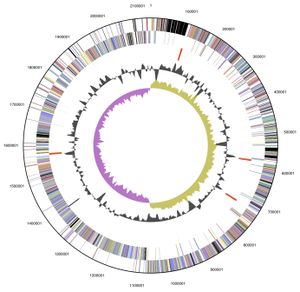User:S4188552: Difference between revisions
| Line 38: | Line 38: | ||
==Pathology== | ==Pathology== | ||
V. parvula has a well established association with human oral diseases, in particular demonstrating a strong association with severe early childhood carries and intraradicular infections <sup>[[#References|[5]]]</sup>,<sup>[[#References|[6]]]</sup>. Recent research has also revealed that ''V. parvula'' is the predominant ''Veillonella'' species within dentine biofilms<sup>[[#References|[10]]]</sup>. | ''V. parvula'' has a well established association with human oral diseases, in particular demonstrating a strong association with severe early childhood carries and intraradicular infections <sup>[[#References|[5]]]</sup>,<sup>[[#References|[6]]]</sup>. Recent research has also revealed that ''V. parvula'' is the predominant ''Veillonella'' species within dentine biofilms<sup>[[#References|[10]]]</sup>. | ||
Although V. parvula | Although V. parvula generally presents as a commensal or non-pathogenic resident in the bacterial communities of the oropharynx and the gastrointestinal, genitourinary and respiratory tracks <sup>[[#References|[7]]]</sup> | ||
, it has rarely been associated with a number of serious and life-threatening infections. These infections include: osteomyeltitis, spondylodiscitis, discitis, meningitis and sinus infections <sup>[[#References|[7]]]</sup>, <sup>[[#References|[8]]]</sup>. | , it has rarely been associated with a number of serious and life-threatening infections. These infections include: osteomyeltitis, spondylodiscitis, discitis, meningitis and sinus infections <sup>[[#References|[7]]]</sup>, <sup>[[#References|[8]]]</sup>. | ||
Revision as of 00:14, 21 September 2016
Aimee Davidson Bench E Date [1]
Classification
Higher order taxa
Kingdom - Bacteria - Firmicutes - Negativicutes - Selenomonadales - Veillonellaceae - Veillonella [3]
Species
Species name: Veillonella parvula (subspecies parvula) [3]
Type strain: ATCC 10790 = CCUG 5123 = DSM 2008 = JCM 12972 = NCTC 11810 [3]
Description and significance
Give a general description of the species (e.g. where/when was it first discovered, where is it commonly found, has it been cultured, functional role, type of bacterium [Gram+/-], morphology, etc.) and explain why it is important to study this microorganism. Examples of citations [1], [2]
Genome structure
Select a strain for which genome information (e.g. size, plasmids, distinct genes, etc.) is available.
V. parvula exhibits a circular 2.13 Mb (2,132,142 bp) genome, of which 88.46 % is DNA encoding, and was the first member of the Veillonella family to have its complete genome sequenced. Its 1920 genes include: 1859 protein-encoding genes, 61 RNA specific genes and 15 pseduogenes, with an overall GC content of 38.63%. The majority of these genes are predicted to have either an unknown (385 genes) or general function (177 genes). Although those genes with a predicted function are predominately involved with: translation, ribosomal structure, cell wall or membrane biogenesis, energy production and conversion, amino acid, coenzyme and inorganic transport and metabolism [5].

Cell structure and metabolism
Cell wall, biofilm formation, motility, metabolic functions.
Ecology
Aerobe/anaerobe, habitat (location in the oral cavity, potential other environments) and microbe/host interactions.
Pathology
V. parvula has a well established association with human oral diseases, in particular demonstrating a strong association with severe early childhood carries and intraradicular infections [5],[6]. Recent research has also revealed that V. parvula is the predominant Veillonella species within dentine biofilms[10].
Although V. parvula generally presents as a commensal or non-pathogenic resident in the bacterial communities of the oropharynx and the gastrointestinal, genitourinary and respiratory tracks [7] , it has rarely been associated with a number of serious and life-threatening infections. These infections include: osteomyeltitis, spondylodiscitis, discitis, meningitis and sinus infections [7], [8].
Application to biotechnology
Bioengineering, biotechnologically relevant enzyme/compound production, drug targets,…
Current research
Summarise some of the most recent discoveries regarding this species.
References
References examples
3. List of prokaryotic names with standing in nomenclature
- ↑ MICR3004
This page is written by Aimee Davidson for the MICR3004 course, Semester 2, 2016
